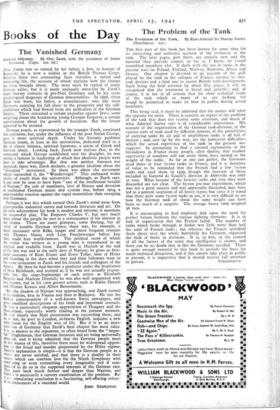The Problem of the Tank
The Evolution of the Tanis. By Rear-Admiral Sir Murray Sueter. (Hutchinson. 155.) THE first part of this book has been known for some time for its interesting and authentic account of the evolution of the tank. The later pages, part three, are entirely new and the material they provide cannot, so far as I know, be found assembled anywhere else. It deals with the use of tanks in the present war—in Poland, Finland, Norway, Rumania, Africa and Greece. One chapter is devoted to an account of the path played by the tank in the collapse of France, another to anti- tank devices and a final one to recent British tank-development. Such being the field covered by about fifty pages, it will be recognised that the treatment is broad and general - and, of course, it is not at all certain that the close technical study of the tank which so many of us are looking for would be permitted to make its bow in public during actual hostilities.
This being said, it must be admitted that the author will whet the appetite for more. There is scarcely an aspect of the problem of the tank that does not receive some attention, and much of what Admiral Sueter says is of considerable importance. His account of the organisation of the German tank-division, of the various sorts of tank used by different nations, of the possibilities of carrying tanks by air and of amphibious tanks is all full of interest and, cast up by the way, are the numerous difficultiea which the actual experience of the tank in the present war suggests. In attempting to find a rational explanation of the breakdown in France many people, after finding that marked superiority of numbers will not assist them, have turned to the weight of the tanks. As far as one can gather, the Germans used three or four 70-ton tanks in France, and it is therefore of value to be reminded that the French had a few 75-ton tanks and used them -in 1939, though the heaviest of those included in General de Gaulle's division at Abbeville was only 31 tons. What became of the heavier tanks and why they were discarded are not clear. The 65-ton pre-war experiment, which was not a great success and was apparently discarded, may have led to a general suspicion of all heavy types; but since it is stated that there were some 75-ton tanks in use, it is very difficult to see how the German tank of about the same weight can have been so much of a surprise. The average heavy tank weighed 36 tons.
It is encouraging to find emphasis laid upon the need for perfect liaison between the various fighting elements. It is in lack of organisation that the French failed. The -number of tanks which broke through at Sedan was little more than half the total of French tanks ; but whereas the French sprinkled them about over the whole battlefield the Germans organised the bulk of theirs in divisions. It is, in fine, in the control of all the factors of the army that intelligence is shown, and there can be no doubt that in this the Germans excelled. There is quite enough material in this book to provide the basis for much technical discussion, and if this cannot take place in public at present, it is imperntive that it should receive full attention


























 Previous page
Previous page